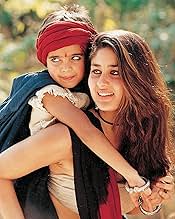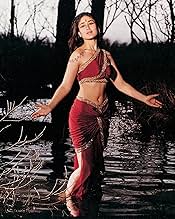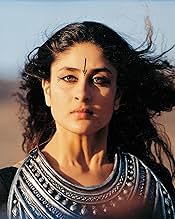IMDb रेटिंग
6.4/10
16 हज़ार
आपकी रेटिंग
मौर्य साम्राज्य के उत्तराधिकारी अशोक को अपने सौतेले भाई सुशीम के साथ लड़ने के लिए निर्वासन पर भेजा जाता है. दक्षिण की यात्रा करते समय उसकी मुलाकात कलिंग की राजकुमारी कौरवकी से होती है और उसे... सभी पढ़ेंमौर्य साम्राज्य के उत्तराधिकारी अशोक को अपने सौतेले भाई सुशीम के साथ लड़ने के लिए निर्वासन पर भेजा जाता है. दक्षिण की यात्रा करते समय उसकी मुलाकात कलिंग की राजकुमारी कौरवकी से होती है और उसे उससे प्यार हो जाता है.मौर्य साम्राज्य के उत्तराधिकारी अशोक को अपने सौतेले भाई सुशीम के साथ लड़ने के लिए निर्वासन पर भेजा जाता है. दक्षिण की यात्रा करते समय उसकी मुलाकात कलिंग की राजकुमारी कौरवकी से होती है और उसे उससे प्यार हो जाता है.
- पुरस्कार
- 3 जीत और कुल 17 नामांकन
Gerson Da Cunha
- King Bindusara
- (as Gerson da' Cunha)
Subhashini Ali
- Dharma
- (as Subhashini)
Johny Lever
- Magadha Soldier
- (as Johnny Lever)
Raghubir Yadav
- Magadha Soldier
- (as Raghuvir Yadav)
Sabir Masani
- Giri
- (as Shabir Masani)
कहानी
क्या आपको पता है
- ट्रिवियाShah Rukh Khan wanted Aishwarya Rai Bachchan to be cast in the role of Kaurwaki. However, the director, Santosh Sivan, wanted to cast an actress with whom he hadn't already been paired in a leading role. Shahrukh also recommended Sushmita Sen to play the singing dancer in the bar.
- इसके अलावा अन्य वर्जनInternational version runs 150 minutes. Uncut version runs 180 minutes
- कनेक्शनFeatured in 47th Filmfare Awards (2002)
- साउंडट्रैकSan Sanana
Written by Anand Bakshi
Composed by Anu Malik
Performed by Alka Yagnik and Hema Sardesai
Courtesy of Sony Music India
फीचर्ड रिव्यू
2001, in spite of everything, might be remembered as the year Bollywood met Hollywood in the flesh. Years from now, film historians, critics, and fans will remember this film as a landmark, an unparalleled achievement. This incredible film really needs to be seen on the big screen to be appreciated fully.
Santosh Sivan, the gifted cinematographer best known in the USA for the art-house hit "The Terrorist," and in India for his work with director Mani Ratnam, switches gears completely. While "The Terrorist" was a tiny, contemplative drama, "Asoka" is bigger than big, a total opposite. In fact, I read that the war sequence was the largest of its kind ever filmed in the history of Indian cinema.
Asoka, a little-known figure in the West, was a bloodthirsty maniac who became a bastion for peace and tolerance through Buddhism in the 3rd century, ce. The film is a journey, a character study, of Asoka's progression to the time when he first embraced the Buddha. Some have complained that there is nothing in the film about his conversion to Buddhism, but that is really not the film's point. The events that led up to this transformation are what the film is really about.
Particular attention needs to be made to the cinematography and editing--it is nothing short of extraordinary. Done with an uncanny sensitivity, Sivan brings third century India to breathing, bustling life in a way that, perhaps, no one else could deliver with such vitality and beauty. However, portions of the editing are a little too MTV for my taste, with white flashes and jump-cuts interrupting establishing shots. It functions well, though, during the fight scenes. It is a strange dichotomy between art and commercial cinema. You'll never see swordplay in the same way again.
Pay attention to the acting, too--it is excellent. Kareena Kapoor proves that she's a much finer actress than her older sister, Karisma, and Shahrukh Khan, currently India's biggest star, gives the performance of his life. Both show incredible nuances. Also, Suraj Balaje, who plays the young prince Arya, shows a surprising maturity, and even comedian Johnny Lever, in a cameo role as a soldier, is excellent. If you are not familiar with commercial Indian cinema, the acting may seem like it is a bit over the top, but here, the entire cast, especially the leads, shows tremendous restraint. Know, however, that the over-the-top acting style, a staple of commercial Indian cinema, has a direct connection to traditions that are hundreds and hundreds years old, in the classical styles of the Sanskrit and Parsee theater.
The inevitable comparisons between "Crouching Tiger, Hidden Dragon" and "Asoka" are warranted. This is the first commercial Indian film to receive nationwide distribution in the US, in this case through the independent First Look Pictures, and it is poised to bring an otherwise unknown filmmaking tradition in the American mainstream to a wide US audience. Both films are sumptuous recreations of history, although this film is based on an actual historical figure and CTHD is based on a novel. Both films have amazing fight choreography, "Asoka's" done without the aid of computers. Personally, I am biased toward commercial Indian cinema because it holds much more of a mystique. Sadly, because of the image that commercial Indian cinema holds in the USA, it may never see the wide audience that this film so deserves.
Whereas the Hong Kong action picture has heavy doses of martial arts, the commercial Indian film has songs, akin to musicals but, in this case, more like music videos. There are five songs in the film, and they may be a turn-off to those not familiar with mainstream Indian cinema. However, they are well-integrated into the story line, and they are among the best filmi (Indian film songs) I have ever heard, combining modern and ancient instruments with just a touch of electronica. The film really loses some of its impact if they are cut--they are that important. They are well-picturized (term for the filming of musical numbers in Indian cinema) and provide additional atmosphere. The influence of MTV is apparent in the editing style that takes over during the song sequences; this may interrupt the film's rhythm and impact, but they are part of the overall story. Unfortunately, I believe that the song sequences are being cut severely for international release, although I was lucky enough to see them in full DTS digital sound. Because of the need for Indian cinema to appeal to as wide an audience as possible (the all-India film), and because film-going in India is a family experience, films try to appeal to all members of the family. This means that violent scenes can turn into comedy, many genres are often combined, and there is neither sex nor nudity, not even kissing on the lips, because of a puritanical society. Overall, this may be seem cheesy to American audiences, but this is one of the pleasures of commercial Indian cinema. It is strange, though, with its lack of any nudity or sex, which are all suggested but never shown, that the film received an R rating. Yes, it is VERY violent, but the violence is quite stylized and often uses the power of suggestion rather than actual representation. I hope sincerely that, when First Look releases the DVD, the film is completely uncut and complete, with ALL the songs.
The film's last song, "Raat Ka Nasha," would be my Oscar pick for best song, an exemplar of superior filmi. The film itself definitely deserves an Oscar for Best Foreign-Language Film. It is a big bonus to see a film of such high production values devoid of any references to Western civilization or without any Western aesthetics. Incredibly entertaining, something for everyone (music, drama, romance, violence), with unparalleled high-quality production values and a moving story, "Asoka" is a dynamite cinematic experience. It is that good. Peace.
Santosh Sivan, the gifted cinematographer best known in the USA for the art-house hit "The Terrorist," and in India for his work with director Mani Ratnam, switches gears completely. While "The Terrorist" was a tiny, contemplative drama, "Asoka" is bigger than big, a total opposite. In fact, I read that the war sequence was the largest of its kind ever filmed in the history of Indian cinema.
Asoka, a little-known figure in the West, was a bloodthirsty maniac who became a bastion for peace and tolerance through Buddhism in the 3rd century, ce. The film is a journey, a character study, of Asoka's progression to the time when he first embraced the Buddha. Some have complained that there is nothing in the film about his conversion to Buddhism, but that is really not the film's point. The events that led up to this transformation are what the film is really about.
Particular attention needs to be made to the cinematography and editing--it is nothing short of extraordinary. Done with an uncanny sensitivity, Sivan brings third century India to breathing, bustling life in a way that, perhaps, no one else could deliver with such vitality and beauty. However, portions of the editing are a little too MTV for my taste, with white flashes and jump-cuts interrupting establishing shots. It functions well, though, during the fight scenes. It is a strange dichotomy between art and commercial cinema. You'll never see swordplay in the same way again.
Pay attention to the acting, too--it is excellent. Kareena Kapoor proves that she's a much finer actress than her older sister, Karisma, and Shahrukh Khan, currently India's biggest star, gives the performance of his life. Both show incredible nuances. Also, Suraj Balaje, who plays the young prince Arya, shows a surprising maturity, and even comedian Johnny Lever, in a cameo role as a soldier, is excellent. If you are not familiar with commercial Indian cinema, the acting may seem like it is a bit over the top, but here, the entire cast, especially the leads, shows tremendous restraint. Know, however, that the over-the-top acting style, a staple of commercial Indian cinema, has a direct connection to traditions that are hundreds and hundreds years old, in the classical styles of the Sanskrit and Parsee theater.
The inevitable comparisons between "Crouching Tiger, Hidden Dragon" and "Asoka" are warranted. This is the first commercial Indian film to receive nationwide distribution in the US, in this case through the independent First Look Pictures, and it is poised to bring an otherwise unknown filmmaking tradition in the American mainstream to a wide US audience. Both films are sumptuous recreations of history, although this film is based on an actual historical figure and CTHD is based on a novel. Both films have amazing fight choreography, "Asoka's" done without the aid of computers. Personally, I am biased toward commercial Indian cinema because it holds much more of a mystique. Sadly, because of the image that commercial Indian cinema holds in the USA, it may never see the wide audience that this film so deserves.
Whereas the Hong Kong action picture has heavy doses of martial arts, the commercial Indian film has songs, akin to musicals but, in this case, more like music videos. There are five songs in the film, and they may be a turn-off to those not familiar with mainstream Indian cinema. However, they are well-integrated into the story line, and they are among the best filmi (Indian film songs) I have ever heard, combining modern and ancient instruments with just a touch of electronica. The film really loses some of its impact if they are cut--they are that important. They are well-picturized (term for the filming of musical numbers in Indian cinema) and provide additional atmosphere. The influence of MTV is apparent in the editing style that takes over during the song sequences; this may interrupt the film's rhythm and impact, but they are part of the overall story. Unfortunately, I believe that the song sequences are being cut severely for international release, although I was lucky enough to see them in full DTS digital sound. Because of the need for Indian cinema to appeal to as wide an audience as possible (the all-India film), and because film-going in India is a family experience, films try to appeal to all members of the family. This means that violent scenes can turn into comedy, many genres are often combined, and there is neither sex nor nudity, not even kissing on the lips, because of a puritanical society. Overall, this may be seem cheesy to American audiences, but this is one of the pleasures of commercial Indian cinema. It is strange, though, with its lack of any nudity or sex, which are all suggested but never shown, that the film received an R rating. Yes, it is VERY violent, but the violence is quite stylized and often uses the power of suggestion rather than actual representation. I hope sincerely that, when First Look releases the DVD, the film is completely uncut and complete, with ALL the songs.
The film's last song, "Raat Ka Nasha," would be my Oscar pick for best song, an exemplar of superior filmi. The film itself definitely deserves an Oscar for Best Foreign-Language Film. It is a big bonus to see a film of such high production values devoid of any references to Western civilization or without any Western aesthetics. Incredibly entertaining, something for everyone (music, drama, romance, violence), with unparalleled high-quality production values and a moving story, "Asoka" is a dynamite cinematic experience. It is that good. Peace.
- MuzikJunky
- 1 नव॰ 2001
- परमालिंक
टॉप पसंद
रेटिंग देने के लिए साइन-इन करें और वैयक्तिकृत सुझावों के लिए वॉचलिस्ट करें
- How long is Asoka?Alexa द्वारा संचालित
विवरण
- रिलीज़ की तारीख़
- कंट्री ऑफ़ ओरिजिन
- भाषा
- इस रूप में भी जाना जाता है
- Samrat Ashoka
- फ़िल्माने की जगहें
- Konark, Orissa, भारत(outdoor filming)
- उत्पादन कंपनियां
- IMDbPro पर और कंपनी क्रेडिट देखें
बॉक्स ऑफ़िस
- बजट
- ₹13,00,00,000(अनुमानित)
- US और कनाडा में सकल
- $7,31,277
- US और कनाडा में पहले सप्ताह में कुल कमाई
- $3,37,464
- 28 अक्तू॰ 2001
- दुनिया भर में सकल
- $14,05,414
- चलने की अवधि3 घंटे
- रंग
- ध्वनि मिश्रण
- पक्ष अनुपात
- 2.35 : 1
इस पेज में योगदान दें
किसी बदलाव का सुझाव दें या अनुपलब्ध कॉन्टेंट जोड़ें


































